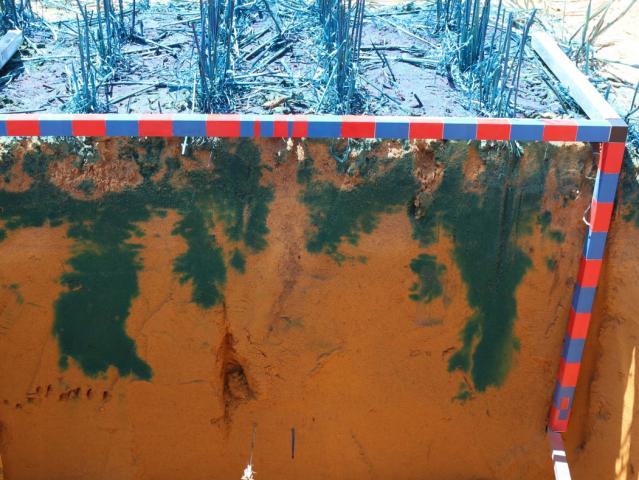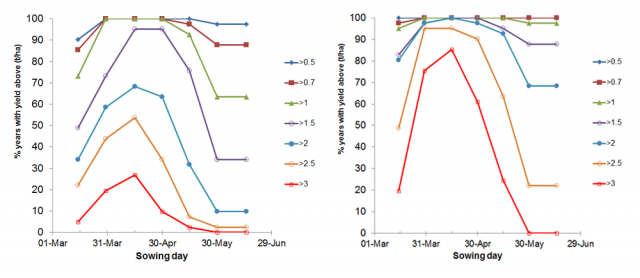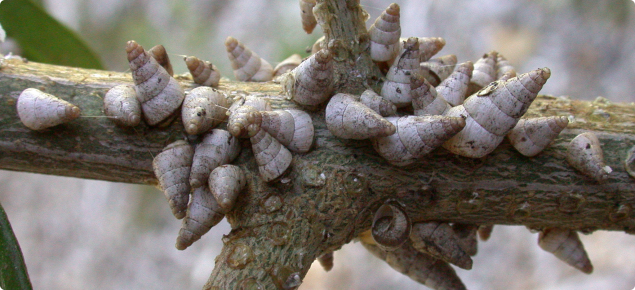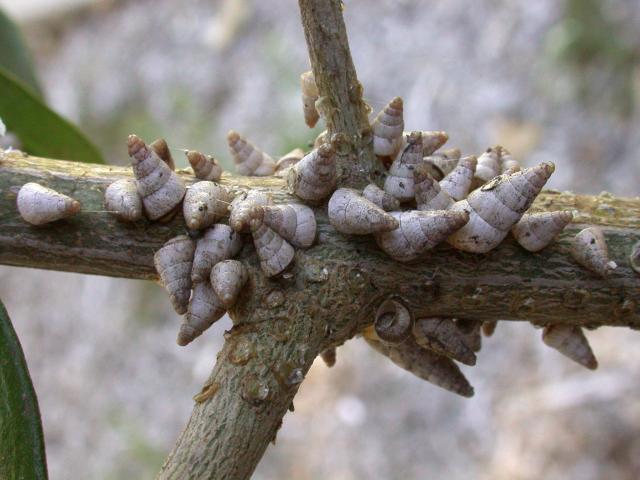In this edition...
New canola online tool available
A new resource is available to grain growers and consultants to help interpret soil and tissue test results and manage nutrition in their canola crops.
Benefits of on-row sowing to combat water repellent soils
Soil wettability in water repellent soils is often slow and uneven with water entering the soil via preferred pathways, while leaving other neighbouring areas of the soil completely dry.
Eye spy on snails and slugs
A national research project involves monitoring the commonly found small pointed snail (Prietocella barbara ), black keeled slug (Milax gagates) and vineyard snail (Cernuella virgata) at four sites between Albany and Esperance.
Canola sowing time to maximise yield in Western Australia
In the last decade there has been a trend towards earlier sowing of canola by Western Australian growers. However, there is little experimental data on very early sowings before mid-April. A computer modelling study was designed to establish the optimum sowing window to maximise grain yield accounting for frost and heat stress for different locations in WA.
Does topsoil slotting increase yield?
Topsoil slotting uses soil inclusion plates attached to the rear of deep ripping tines. The practice has been shown to increase the yield from deep sandy soils more than deep ripping alone, however the value of the topsoil slotting plate is still being determined.
Grains research papers now available online
A wealth of research papers accompanying the Grains Research and Development Corporation’s (GRDC) recent Research Updates are now available online.
A new app to help manage black-leg in Canola
A new app assists growers and advisers with managing blackleg disease in canola crops by integrating the information provided in the Blackleg Management Guide and by producing a potential economic outcome.
Circumvent early crop disease risks
If weeds and/or volunteer crop plants are present at the start of this new cropping season, particularly in or adjacent to cropping paddocks, there is a greater risk of spread of pests and diseases to newly emerging crops.
New canola online tool available
A new resource is available to grain growers and consultants to help interpret soil and tissue test results and manage nutrition in their canola crops.
The Critical nutrient levels for canola in Western Australia online tool was developed by the Department of Primary Industries and Regional Development (DPIRD), with the support of the Grains Research and Development Corporation (GRDC).
For each crop nutrient, a table has been developed to highlight the likely yield impact of different soil or plant tissue test results on seed yield.
All major macro and micro nutrients are included in the tool. These include the macro nutrients phosphorous, sulphur, potassium and nitrogen, and the micro nutrients copper, zinc, manganese, molybdenum and boron.
The tool also includes the main soil constraints found in WA including soil acidity, soil alkalinity, aluminium toxicity, sodicity, compaction and salinity.
A traffic light system has been used to indicate the urgency of addressing nutrient or soil constraint issues.
The traffic light chart quickly highlights whether nutrient levels in the soil or plant are likely to result in reduced seed yield and also estimates the severity of expected yield losses (Figure 1).
Where the traffic light shows a test result as red, this means yield losses of more than 25% are likely, meaning this particular issue needs addressing as a priority.
Where a test result is orange, yield loss between 15-25% are likely, yellow indicates 5-15% losses and green estimates less than 5% yield loss.
| Yield loss | >25% | 15-25% | 5-15% | <5% |
| Phosphorous 0-10cm soil test (mg/kg)(Colwell P) | <13 | 13-16 | 16-22 | >22 |
| Phosphorous in whole tops at seedling stage (%) | <0.27 | 0.27-0.35 | 0.35-0.4 | >0.4 |
| Phosphorous in whole tops at rosette stage (%) | <0.18 | 0.18-0.23 | 0.23-0.27 | >0.27 |
This content is not intended to replace professional paddock specific advice, but to help growers and consultants determine where best to target their fertiliser or soil amelioration investment to ensure good canola crop nutrition and to optimise crop potential and profit.
The web pages include a lot of general information about canola nutrition and the behaviour of each nutrient in soils and plants, as well as suggestions for remedial action.
There are also links to other information to help diagnose crop constraints and paddock management tools.
The critical levels have been developed by DPIRD staff, drawing on many research trials conducted over several years.
For more information contact Andrew Blake, Development Officer, Geraldton on +61 (0)8 9956 8564.
Benefits of on-row sowing to combat water repellent soils

Soil wettability in water repellent soils is often slow and uneven.
Water enters the soil via preferred (less repellent) pathways, while leaving other neighbouring areas of the soil completely dry.
In hilly landscapes water can run off and end up in lower parts of the landscape.
Depending on the severity of the water repellence and the frequency and intensity of rainfall the dry patches in the soil can be very persistent sometimes remaining dry for the whole growing season.
On-row sowing to help water infiltration
Research by CSIRO and DPIRD has now clearly demonstrated that water will preferentially infiltrate where there are residual plant crowns and root systems remaining from the previous season’s crop (see image above).
Residual and new roots act as preferred pathways for water and this can be used to advantage when seeding the current season’s crop.
The importance of on-row seeding increases with drier starts to the season with small and infrequent break-of-season rains.
Seeding on or right alongside the previous seasons’ rows can result in seed being placed into the zone that preferentially wets and allowing earlier and more even crop germination.
This on-row soil zone will continue to preferentially wet even after crop establishment, allowing crops to benefit from smaller rainfall events.
CSIRO research, by Margaret Roper and Phil Ward, has shown that in addition to the roots from the previous season acting as physical pathways for water infiltration, the residual crop rows can have lower repellence and higher numbers of microbes which break-down the water repellent organic compounds that cause the problem.
2017 on-row trial results near Moora
In 2017 at a research site on repellent sand near Moora, changing the seeder bar resulted in a mix of on-and inter-row sowing of lupins onto 2016 barley stubbles.
With a dry start to the season on-row sowing had a large impact on crop establishment and growth.
This was comprehensively demonstrated by early plant counts and groundcover analysis using aerial imagery from a drone.
On 1 July the average groundcover in the untreated control plots was 5.1% for the off-row and more than double for the on-row with 10.7% groundcover.
These differences persisted such that, 2 months later, on 1 September groundcover was nearly tripled for the on-row seeding with 33.4% groundcover compared to only 11.7% for the off-row.
This effect was driven by improved water infiltration on the previous season’s barley row.
The establishment and growth differences translated into grain yield differences, measured from extensive hand harvest cuts, of 1.1 t/ha for the off-row sown lupins compared to 2.5 t/ha for the on-row sown lupins.
It is also important to note that when the water repellence was effectively removed, such as in the spading treatments at the same site, the differences in plant establishment and yields were significantly reduced (45.9% groundcover for the off-row and 53.7% for the on-row when measured on 1 September with 2.2 and 2.3 t/ha of lupin, respectively).
Achieving accurate on-row sowing
Achieving accurate on-row sowing can be tricky and approaches vary from across row sowing, which compromises controlled traffic farming (CTF) systems, through to having hydraulic steering on the seeder bar so accurate placement can be achieved.
Some growers with well-established CTF systems and straight seeding runs have successfully used bar-mounted cameras so they can see the row placement and just nudge the bar across to effectively seed alongside the previous season’s row.
Many questions still remain about the possible advantages and disadvantages of on-row sowing but it is apparent that it is an effective strategy for improving crop establishment on repellent soils, especially in seasons with a dry start and when trying to establish a crop on a small break-of-season rainfall event.
More information can be found;
- Grains Research Updates paper S14 Betti Giacomo 2018 How can we ameliorate water repellent soils
- Water repellence webpage of the DPIRD website.
For more information contact Giacomo Betti, Research Officer, DPIRD Geraldton, +61 (0)8 9956 8554 or Stephen Davies, Research Officer, DPIRD Geraldton, +61 (0)8 9956 8515.
Eye spy on snails and slugs
A national research project to provide growers with regionally specific information for controlling mollusc pests has been funded by the Grains Research and Development Corporation (GRDC).
The focus in each region is on the ecology, behaviours and biology of the most damaging snail and slug species.
In Western Australia, this involves monitoring the commonly found small pointed snail (Prietocella barbara ), black keeled slug (Milax gagates) and vineyard snail (Cernuella virgata) at four sites between Albany and Esperance, which includes the use of cameras.
All pest slugs and snail species in Australia have been introduced to.
Snails are easily introduced onto farms by vehicles, machinery, pot plants and pallets.
This means that good biosecurity can stop the spread of snails.
Slugs on the other hand, tend to move within paddocks and between farms, however they are limited to areas where there is sufficient soil moisture to survive a hot, dry summer.
It can take years for both of these pests to build up to high numbers to be damaging.
Monitoring
Cameras at Munglinup currently show snails are actively feeding and mating has been observed.
Dissection of snails show that the albumen gland has started to increase in size. This indicates that the snail or slug is about to lay eggs.
Footage from cameras at Gairdner show round snails are actively moving at night and mating has started.
While cameras closer to Albany show only small pointed snails and reticulated slugs moving at night and feeding on baits.
Farmers who applied baits in Munglinup have reported finding dead snails around each bait.
Control - Baiting
If snails and slugs are causing damage to crops, the only option is to bait.
Snails may not be active everywhere, so farmers should consider applying snail baits to a small area prior to baiting entire paddocks, to make sure snails are actively feeding and moving.
Even though slugs have not been observed in the paddock being monitored in this project it is possible that they are active in wetter parts of the paddock.
Laying a line of baits out after a rain event will give an indication of where slugs are present.
GRDC supported trials have shown it does not matter what bait you use, rather the more baits points per square metre and the more even the coverage the better the kill.
Rainfast baits do last longer than non-rainfast baits in the field.
More than one bait application can be needed in a single season to control snails as well as slugs.
Baits will compete with the crop to be ‘attractive’ to snails and slugs, the best time to bait is prior to sowing or straight after before the crop emerges.
If baiting is needed, better calibration of bait spreaders results in better baiting, saving time and money.
The more even the bait distribution is, the more likely snails will come into contact with bait, resulting in better control.
Control - Burning
Farmers may consider other control options to baiting such as windrow burning for snail control.
This method was found to be effective in Department of Primary Industries and Regional Development (DPIRD) trials in 2015 initiated by the GRDC’s Albany Regional Cropping Solutions Networks (RCSN) group.
In a canola paddock with standing stubble next to the windrows, the highest proportion of snails was in the windrow - at more than 200 per square metre.
Burning the windrow led to a significant reduction in snail populations.
Even though burning does not necessarily control black keeled slugs it does decrease surface refuges and makes it more likely that these pests will come across baits in the paddock.
Remember, even if snails and slugs are not found in high numbers and are not causing crop damage, their numbers can build up over time and pose a threat to germinating crops in the future. Therefore, continue to monitor you slug and snail numbers.
Further information and alternative options are available on the Identification and control of pest slugs and snails for broadacre crops in Western Australia webpage on the DPIRD website.
For more information contact Svetlana Micic, Research Officer, Albany, +61 (0)8 9892 8591.
Canola sowing time to maximise yield in Western Australia
In the last decade there has been a trend towards earlier sowing of canola by Western Australian growers.
Sowing canola in mid-April has become standard practice in most of the WA cropping zone.
Yield declines with sowing date, ranging from 5-12% per week delay in sowing, have been found in several Australian studies (Farre et al., 2002).
However, there is little experimental data on very early sowings before mid-April.
A computer modelling study was designed to establish the optimum sowing window to maximise grain yield accounting for frost and heat stress for different locations in WA.
Optimum sowing window
The simulations looked at three canola cultivars with various season maturity: long (Hyola 650TT), medium (ATR Bonito) and short (Stingray).
The simulations were set with 10mm irrigation at sowing to ensure crop germinated immediately.
Crop emergence was around 10 days after sowing, depending on sowing depth and temperature.
The optimum sowing window for each location and cultivar was defined as the sowing period when the average yield for the 41 years simulated is within 95% of the maximum yield.
As expected, simulated yields vary greatly from year to year and therefore, in some years, high yields could be achieved with sowing outside of the suggested sowing window.
As a rule of thumb, in low and medium rainfall locations, the optimum sowing period for a medium maturity cultivar is April and in the high rainfall locations the optimum sowing window spans from early April to mid or late May, depending on location and soil type.
Additionally, in general, light soils have earlier optimum sowing windows than heavy soils (about one week earlier) and the duration of the optimum sowing window is about a week shorter in light soils than in heavy soils.
Risk
With late sowing, it is important to assess chances of achieving a certain yield.
For example, in Wongan Hills, there is a reasonable chance (more than 89%) of getting 1.0t/ha when sowing between the beginning of April and mid-May, but this is reduced to around 60% for sowing at the end of May, Figure 1.

This is based on the last 41 years of climate data.
In any given year, a later sowing may yield well if the rain is optimally distributed throughout the season.
The APSIM model results are a guide, so if you have information that your soil is better than average, that the season is looking to be better than average, or that the price is looking better than average you should take these things into account.
For a more in-depth explanation of these results please visit the webpage Canola sowing time to maximise yield in Western Australia.
For more information contact Immaculada Farre, Research Officer, South Perth on +61 (0)8 9363 4164.
Does topsoil slotting increase yield?
Topsoil slotting uses soil inclusion plates attached to the rear of deep ripping tines.
The practice has been shown to increase the yield from deep sandy soils more than deep ripping alone, however the value of the topsoil slotting plate is still being determined.
Three years after investigations began at several locations across the Wheatbelt there is evidence of a trend to greater yields with deeper ripping combined with topsoil slotting.
Ripping treatments were applied once in 2015 and since then the paddock has been managed by the grower, under controlled traffic, to observe how long a yield response from ripping can be maintained.
The following highlights the results from three selected locations.
Binnu
A challenging season at Binnu in 2017 did not provide significant yield differences between any of the treatments though differences in greenness and biomass were visible throughout the season.
The deeper ripping with topsoil slotting plates provided an additional 7% yield over deeper ripping alone, although this only amounted to an estimated 30kg/ha.
Ongerup
The gritty grey clay at Ongerup is a challenging soil to farm profitably.
When dry, it has very high soil strengths and is difficult to rip.
Clods are still present three years after being dragged to the surface during the ripping process of 2015.
The trial site is susceptible to water logging and the soil is sodic at toxic levels below 300mm.
The deeper ripping penetrated to 400mm and has met with the toxicity.
Where topsoil slotting plates are present the organic matter buried to depth has provided some buffering of this sodicity.
This has combined with the increased drainage from the deeper ripping to provide yield improvements over nil ripping.
Deeper ripping with slotting has increased yield by 23% over the control treatment (no ripping), and by 9% over the deeper ripping alone.
Munglinup
The sand over gravel at Munglinup was deep ripped to 600mm.
Responses from this site have been large with controlled traffic maintaining a yield response of 20% in the deeper ripped with topsoil slotting treatment.
Here slotting appears to provide an additional 4% over deeper ripping alone.
Ongoing data collection
These trials have one season remaining to collect observations and data.
With this further information it is hoped the value of topsoil slotting can be determined to help growers make decisions on how top soil slotting and deep ripping fit into the farming system.
This information is brought to you by the Grains Research and Development Corporation (GRDC) funded project Minimising the impact of compaction on crop yield, Project No DAW000243 managed by the Department of Primary Industries and Regional Development (DPIRD).
More information can be found at the Deep ripping for soil compaction page of the DPIRD website.
For more information contact Wayne Parker, Research Officer, Geraldton on +61 (0)8 9956 8511.
Grains research papers now available online
A wealth of research papers accompanying the Grains Research and Development Corporation’s (GRDC) recent Research Updates are now available online.
The 2018 Grains Research Update is an annual two day event which showcases the latest research, technology, market development and management innovations to improve the productivity and profitability of the WA grains industry.
Twenty-five Department of Primary Industry and Regional Development (DPIRD) research and development officers showcased their latest research at the event.
A variety of topics were presented to audience members and a considerable amount of research work was provided to delegates in written format.
These free research papers are now available on the GIWA Research Updates papers webpage.
Some of these include:
- Are you considering harvest weed seed destruction in 2018? Here are a few more things to think about
- New app’s for the WA grains industry - Crop Scout, Blackleg CM, Sclerotinia
- Understanding the impact of a comprehensive range of strategic deep tillage practices on crop performance and soil properties for two repellent soil types
- Is April the best sowing opportunity for wheat or are there other opportunities
- Emerging weeds
- Wheat variety performance across WA in the 2017 National Variety Trials
- Herbicide tolerance in oats and canola
A new app to help manage blackleg in Canola
A new app with the potential to revolutionise the management of blackleg has been released by the Department of Primary Industries and Regional Development (DPIRD).
The blackleg canola management app, known as BlacklegCM, was unveiled at the recent 2018 Grains Research and Development Corporation (GRDC) Grains Research Update in Perth.
The BlacklegCM has been developed by the National pathogen modelling project, led by Northam-based DPIRD officer Jean Galloway and co-invested by GRDC.
It assists growers and advisers with managing blackleg disease in canola crops by integrating the information provided in the Blackleg Management Guide and by producing a potential economic outcome.
The app harnesses 30 years worth of data and information compiled in the Blackleg Management Guide to help identify the most profitable management strategy for individual scenarios.
It enables the user to compare the likely economic outcome of various strategies, such as paddock selection, variety choice, seed dressing, banded fungicide and sprayed fungicide.
The app considers the cost, yield and grain price to generate the best case, worst case and most likely estimates of financial return.
Once all the paddock and farm parameters have been entered into the app, it can determine the likely blackleg severity, yield loss and economic return.
Growers and consultants can enter as many comparisons as desired to determine the best way to manage the blackleg disease risk to reduce its impact and optimise crop productivity and profitability.
The strength of the app is that it can calculate a range of interactions at once to produce results that are tuned to the paddock and the local environment.
It can also be updated after sowing if there are any changes to the input parameters, such as canola prices or yield potential.
The app has been tested extensively and will be updated continuously, as new varieties, disease ratings and management options become available.
The University of Melbourne, NSW Department of Primary Industries, CSIRO, the South Australian Research and Development Institute and Victorian consultants Marcroft Grains Pathology also contributed to the development of the app.
More information and the app are available at the BlacklegCM app webpage on the DPIRD website.
For more information contact Art Diggle, Principle Research Officer, South Perth on +61 (0)8 9368 3563.
Circumvent early crop disease risks
If weeds and/or volunteer crop plants are present at the start of this new cropping season, particularly in or adjacent to cropping paddocks, there is a greater risk of spread of pests and diseases to newly emerging crops.
Volunteer regrowth has been reported in several areas of the wheatbelt this year with wheat stem rust and barley net blotches found in regrowth barley at South Stirling (lower great southern).
You can employ some proactive management strategies to minimise potential disease impacts on your crops this season.
Biotrophic diseases
Biotrophic diseases are carried over on green bridge (volunteer plants, weeds).
These include rusts on wheat and barley, and mildew on wheat, barley, oats and canola.
Root (take-all, rhizoctonia, common root rot) and crown (crown rot) diseases, and nematodes (cereal cyst nematode, root lesion nematode) can also be supported by a green bridge.
Management strategies – remove the green bridge by use of herbicides and grazing at least four weeks prior to seeding, use registered fungicides at seeding (seed dressing or in-furrow) in areas at risk of early disease.
Necrotrophic diseases
Necrotrophic diseases are carried over on stubble and include powdery mildew, wheat yellow spot and Stagonospora (septoria) nodorum, barley scald and net blotches, canola blackleg, sclerotinia stem rot (when sclerotes present in the stems) and white leaf spot, field pea black spot, chickpea ascochyta, cereal crown rot and take-all.
Management strategies - crop rotation with good grass weed control and avoiding sowing alongside or downwind of infected stubble, use registered fungicides at seeding (seed dressing or in-furrow).
Diseases carried by vectors
Diseases carried by vectors such as aphids or mites which survive summer on green bridge include barley yellow dwarf virus, wheat streak mosaic virus, and beet western yellows virus.
Management strategy – remove the green bridge.
Seed borne diseases
These include anthracnose in lupins, ascochyta in chickpea, barley scald, cereal smuts and bunts, net-type net blotch (but not considered a big risk when compared to blown in infection from wind borne spores), and wheat streak mosaic virus.
Management strategies – seed testing, get new clean seed, use registered fungicides at seeding (seed dressing or in-furrow).
Soil borne diseases
These include lupin brown spot, common bunt of wheat, flag smut of wheat, covered smut of barley, loose and covered smut of oats, root diseases (common root rot, rhizoctonia, Pythium root rot, take-all) and nematodes (cereal cyst nematode, and root lesion nematode).
Management strategies – soil testing (particularly if you observed any uneven growth or bare patches in your crops last year), crop rotation with good weed grass control, fallow, use registered fungicides at seeding (seed dressing or in-furrow).
Where sclerotinia stem rot has previously occurred, sclerotinia fruiting bodies called sclerotes can survive in soil for up to six years infecting canola, lupins, chickpeas and lentils. So non-host species, such as cereals, should be grown for at least three years in paddocks that were recently affected.
Some other key tips:
- Plan variety choices and crop rotations to minimise disease risks. Find out more crop specific disease management and the disease ratings of different varieties on the Crop Disease webpage of the Department of Primary Industries and Regional Development (DPIRD) website.
- Monitor and report to PestFax any presence of disease on volunteer cereals or early sown crops.
- Consider use of registered seed or in-furrow fungicide treatments for seed-borne or other diseases your crop could be at risk of (including foliar and root diseases) to avoid the need for early fungicide sprays if early disease strikes. See the crop disease webpage for more information.
- Be aware of foliar fungicide product registrations, limits on number of times a particular mode of action can be used on a crop per season, optimal timing and rates of sprays for effective control, and withholding periods for grazing and harvesting.
- Check out the PestFax map showing what diseases were reported from your area last season to give you an idea of what diseases might be a higher risk next season. Be sure to subscribe to the PestFax newsletter if you haven’t already to receive information on pest and disease finds across the WA wheatbelt next season.
The following webpages contain additional useful information:
- Crop diseases: forecasts and management
- Control of green bridge for pest and disease management
- Registered foliar fungicides for cereals in Western Australia
- Seed dressing and in-furrow fungicides for cereals in Western Australia
For further information contact
Ciara Beard, Plant Pathologist, Geraldton on +61 (0)8 9956 8504,
Geoff Thomas, Plant Pathologist, South Perth on +61 (0)428 947 287 or +61 (0)8 9368 3262,
Kith Jayasena, Plant Pathologist, Albany on +61 (0)8 9892 8477,
Andrea Hills, Plant Pathologist, Esperance on +61 (0)8 9083 1144,
Ravjit Khangura, Canola plant pathologist, South Perth on +61 (0)8 9368 3374,
Brenda Coutts, Virologist, South Perth on +61 (0)8 9368 3266,
Sarah Collins, Nematologist, South Perth on +61 (0)8 9368 3612,
Daniel Huberli, Plant Pathologist (root diseases), South Perth on +61 (0)8 9368 3836.






